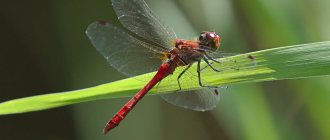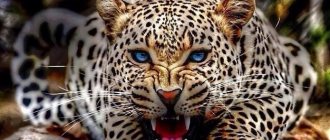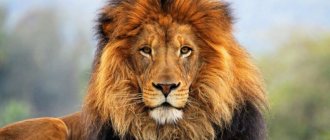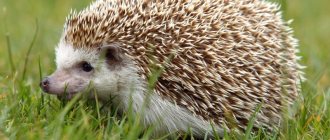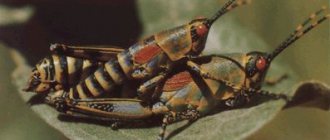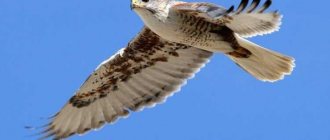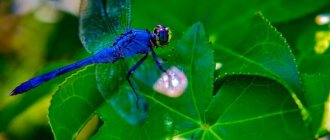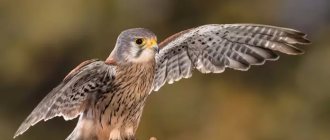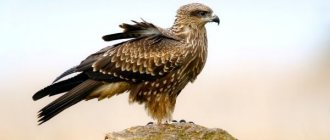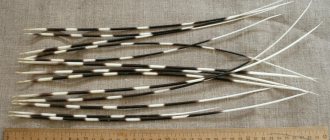Dragonflies are some of the smartest killers in the insect world
The dynamics of catching an object in the air are staggeringly complex, so complex that only animals with complex nervous systems, such as seagulls or humans, can catch objects in the air. To catch something moving at speed, you will have to guess where it will be some time in the future. When scientists began studying dragonflies in 1999, they learned that dragonflies don't "track" their prey by flying through the air, they "intercept" it. In other words, dragonflies ensure a precise kill of the prey by flying to where the prey will be after some time.
This indicates that dragonflies calculate three things when hunting: the distance to their prey, the direction in which it is moving, and the speed at which it is flying. Within milliseconds, the dragonfly calculates the angle from which it should approach, and, like in a horror film, the unfortunate victim is already waiting on the spot, who flies into its claws, without knowing it.
Cockroaches
Cockroaches are the fastest runners of all land insects. In 1991, a world record was set: a representative of Periplaneta americana reached a speed of 5.4 km/h or 50 cockroach body lengths per second. If a person ran at such a speed, then there would be no need for cars. In this case, people could reach speeds of up to 330 km/h.
Dragonflies' eyes are incredibly well developed
Most insects have multi-faceted eyes - for example, the eye of house flies has 6,000 facets, which provide the fly with a panoramic view of its surroundings. That is why, upon closer inspection, their eyes look like honeycombs. But the dragonfly, with 30,000 individual facets in its eye, has completely outperformed not only flies, but also all other insects. Each facet or ommatidium creates its own image, and in the dragonfly's brain there are eight pairs of descending visual neurons, with the help of which dragonflies merge all these pictures into one image.
But that's not all. Dragonflies have visual senses that would be considered super powers by any human standards. There are three opsins in the human eye: proteins that are responsible for the perception of light and give it color in the form of shades of red, green and blue (one shade for each opsin). Dragonflies have four or five opsins in their eyes, which allows them to perceive not only the spectrum of colors we are familiar with, but also ultraviolet light, as well as polarization of the plane of light (an effect that can be observed in polarized sunglasses). This helps them control their flight and reduce their perception of glare from the sun on the water surface.
Photo: Distinctly Average/Flickr
Horseflies
These fast insects of the Diptera family are well known to rural residents. The flight speed of a common horsefly is 65 km/hour. Horseflies parasitize livestock, causing trouble for farmers. Scientists estimate that reindeer spend up to 40% of their time searching for food. The remaining 60% is used to find shelter from horse flies.
Horseflies are common on all continents. The exception is Antarctica.
They see in all directions at once
Dragonflies' huge, bulging eyes are wrapped around their heads like an astronaut's helmet, giving them a 360° panorama of the world. As dragonfly researcher Dr. Alberg said, “They see you clearly when they fly towards you, and they also see you clearly when they fly away from you.” This is obviously an invaluable advantage in helping dragonflies avoid predators. A dragonfly can avoid the sticky feet and tongue of a frog, which leaps to catch the dragonfly from below and behind—a blind spot for most insects. The dragonflies themselves take advantage of this, attacking their victims from behind and from below. But dragonflies have no blind spots, which is why they are notorious for being incredibly difficult to catch.
We'll talk about one more property of dragonfly eyes before moving on. When hunting, the dragonfly's compound eyes allow it to sort of divide its field of vision into sections, like a grid. Visually keeping prey in the same section helps them hunt with incredible precision that allows them to catch something on the fly.
To make it clearer, you can do the following: draw a hash mark on the windshield of your car and select a target. For example, a goat. Point the car in his direction, trying to keep him in the same square. The goat will get larger as the distance closes, but your angle to it will not change even if it moves. You will knock him down 100% of the time. (Please don't actually do this, this is just an example).
Dragonflies are lucky hunters
Dragonflies are excellent hunters. They have keen eyesight and can easily spot small flying insects. Thanks to the special structure of their wings, dragonflies can reach considerable speeds (up to 29 km/h). They snatch prey out of the air, managing to catch 95% of the prey they set out to catch. By comparison, sharks, one of nature's fiercest predators, can only catch half the prey they have their eye on. Lions, which are land sharks, can only catch a quarter of the prey they hunt. And all because they do not calculate the trajectory of their victim’s movement in order to move to intercept it - they chase after it, making zigzags throughout the savannah, repeating the movement of their victims. If dragonflies were big enough to feed on gazelles, lions would simply starve to death, simply due to their sheer inefficiency.
Water strider
Water striders are known as the fastest insects that live on the surface of the water. These representatives of the suborder of bedbugs are capable of moving at a speed of 4-5 km/h
In full accordance with Cassier's law, unique microhairs located on the water strider's legs allow it to glide through the water. The body of the water strider remains completely dry. In slow motion footage, scientists observe the movement of a water strider, which evokes an association with the movements of a speed skater.
Dragonflies have a selective attention span
When we said we wouldn't mention dragonfly eyes again, we lied. In truth, this point contains a new level of previously unseen. When Dr. S.D. Wiederman began studying emerald dragonflies and discovered the way dragonflies select their prey. Intrigued by the dragonfly's hunting process, Dr. Wiederman and his team placed a nanoelectrode in one of the neurons responsible for processing visual information. They placed the experimental individual in front of a TV, on the screen of which two moving objects were shown.
In simple nervous systems, multiple objects gradually become dim because the insect cannot pay attention to multiple targets at once. But dragonflies have the ability to shift attention from one object to another at will. While under observation, the dragonfly focused first on one object, and then moved its attention to another object, after which it returned to the first object, without letting both objects out of sight. This selective range of attention allows the dragonfly to pick out a target in the entire swarm, then focus specifically on it - while at the same time keeping the rest of the swarm in sight to avoid collision.
They have an insatiable appetite
Photo: Krzysztof Niewolny/Unsplash
It's a good thing that dragonflies are naturally adapted to hunting because they are voracious eaters. Stacey Combs, a Harvard researcher who uses high-speed video cameras to study dragonfly flight, says one dragonfly she observed ate thirty flies, one after another, without stopping - and would have eaten more if the flies had not run out.
True to their predatory nature, dragonflies can also eat a range of insects. They usually feed on small flies or mosquitoes - easy prey, but if they manage to catch and kill a butterfly, they will happily eat that too. They also do not disdain small dragonflies, leaving them for a snack.
Dragonflies can move their wings alternately and in any order.
One of the most distinctive characteristics of dragonflies is the way their wings work. Their four wings work independently of each other, allowing the dragonfly to move in the air, much like a helicopter - they can hover, fly forward, backward and sideways, and instantly change direction if they need to. Dragonflies are the only insects in the world that have such advanced control of their wings. Fragile but strong - each wing is attached to the chest using a separate group of muscles.
By making slight shifts and adjustments to each wing as it flies, the dragonfly takes precise aim and freezes directly in the path of the fly flying to its doom. And if a dragonfly catches its prey, then you can expect no mercy, and all because it has a death grip.
Flea
Thanks to its jumping ability, the flea ranks eighth in the list of the fastest insects. Wild and domestic animals often suffer from wingless parasites of the order of blood-sucking fleas. From the ancient Greek language their name is translated as “pump”.
In the absence of wings, fleas have developed a unique jumping ability. Their muscles allow them to jump at speeds of almost 2 meters per second. Fleas are able to move very quickly across the body of an animal covered with thick fur.
Dragonflies crush their prey to pulp.
Their international scientific name is “Odonata”. Translated from Greek, it means “toothy,” which suits them well, since dragonflies crush their prey to a pulp using their powerful, serrated jaws. Generally, people don't think that dragonflies are dangerous; moreover, the jaws of most small dragonflies are not strong enough to tear human skin (although large dragonflies not only can, but do this). However, for a small fly, these jaws mean certain death.
After catching prey, dragonflies do two things: first, they wrap their forepaws around the prey to immobilize it. Their hinged jaws then descend and tear off the fly's wings so that it cannot fly away. After this, the dragonfly calmly eats the fly, without fear that it might somehow escape. Dragonflies' jaws can open as wide as the height of their heads, allowing them to eat literally anything that fits their size, and most often they eat their prey in the air without even landing. Even deadly situations whet their appetite. A dragonfly, stuck in a spider's web, will not become confused and will eat the spider when it gets too close. Some creatures have an insatiable will to live.
Photo: Joeke Pieters/Flickr
Dragonflies are rapists
Before mating, most animals go through some kind of ritual, but dragonflies don’t have time for this - there is plenty of food around that needs to be eaten! Therefore, they forcibly mate with the first female they meet, and the word forcibly is quite appropriate here. The male first locates the female by her flight movements to ensure she is of his species. He then approaches from behind, wraps his front paws around her neck, and sometimes even bites her neck to subjugate her to his will. It then sends signals throughout its body and begins to move the sperm to the desired location. You see, male dragonflies store their sperm in a compartment that is located at the very back of their bodies, even though their penises are higher up. Therefore, once the male has taken a position, he begins to move the sperm.
However, he does not sit idly by during this process. Female dragonflies typically mate with multiple partners. Therefore, in one of the most unusual evolutionary quirks of nature (not counting, of course, the erection-inducing venom of the Brazilian wandering spider), male dragonflies have a kind of barbs on their penises that serve only to scoop out the sperm of the previous male from the female's body. When all the interference is finally eliminated, the male gets down to business - and all this happens while both individuals hover in the air.
In some cases, the male continues to guard the female until her eggs are fertilized with his sperm, so that she is not raped by other males and his chances of becoming a father increase.
Look back
Those who are interested in dragonflies ask whether dragonflies have simple eyes or not? An interesting fact is that these insects have two complex organs of vision, consisting of thousands of facets, as well as three simple ones, each having one lens and located on the crown of the insect. Two compound and three simple eyes allow for an almost all-round view. And together with maneuverability and speed of flight, this is enough for dragonflies to lead a well-fed life.
Even baby dragonflies hunt
When it comes to killing, young dragonflies can even rival adults in the cold-bloodedness of their kills. Like many other insects, dragonflies begin their lives in the larval stage. Dragonfly larvae, or nymphs, live underwater and swim quickly in it, shooting streams of water from their rectums like tiny torpedoes. Some dragonflies live this way for five years before spending a relatively short life span of six or seven months as adults.
During their aquatic life, they prey on small insects and other larvae, especially mosquito larvae, that are in the water with them. But in many species, the diet is not so meager; some dragonfly nymphs even eat tadpoles and guppies, seizing their prey with powerful jaws with the same terrible tenacity that will set the course of their lives as adults. Then the larva crawls onto land and sheds its exoskeleton there. She releases her wings. It may take several days for them to completely dry and harden.
Jumping beetle
The jumping beetle is one of the fastest among insects, whose movement speed can sometimes exceed 2 meters per second. It can be classified as a beneficial insect that destroys pests in gardens and vegetable gardens. One horse can destroy more than 400 harmful insects over the summer. They go hunting in sunny weather. The beetle flies at high speed, but only for short distances. Sensing danger, he instantly rises into the air and, having flown a short distance, falls down. These arthropods can hunt on the fly, but obtain their main food on the ground, chasing insects or larvae. Being one of the fastest runners among his relatives, the hunter easily catches up with the fastest prey. Having grabbed hold of the prey with its powerful jaws, the beetle generously pours gastric juice with digestive enzymes onto it. Under the influence of the juice, the internal organs of the caught prey are partially digested, and after some time the fish can only suck out the nutritious gruel.
Did you know?
- Dragonflies are one of the very first insects to appear on earth. Although now they cannot boast of large sizes, their distant ancestors could reach up to 80 cm in wingspan. Scientists conducted an experiment in which they raised several dragonflies in a test chamber. It recreated oxygen levels similar to the oxygen levels on earth 300 million years ago. The tested individuals grew 15% more than normal.
- Although dragonflies live on average for about six months, some species live only a few weeks after metamorphosis. Some long-livers among dragonflies lived up to a year.
- If a dragonfly injures its wings and can no longer fly, it dies of starvation. This is due to the fact that dragonflies can only hunt in flight.
- Dragonflies can see ultraviolet light, as well as colors that the human eye cannot detect.
- One dragonfly can eat up to one hundred mosquitoes a day.
- Although most insects and animals cannot live in salt water, this is not the case for dragonflies. Some species lay eggs in sea water, while others even live near salt marshes and salt lakes.
- In Asia, and in particular Indonesia, fried dragonflies are one of the most favorite dishes. There are even professional dragonfly hunters who supply the insects to chefs.
- To protect many species of dragonflies from imminent extinction, special centers have been created around the world. They support the conservation of dragonfly species diversity.
